Technical Description Product
Nadeem Alli
The Grove School of Engineering, City College of New York
ENGL 21007: Writing for Engineering
Professor Crystal Rodwell
March 10, 2021
Product: Galaxy Buds Pro
Table of Contents:
- Introduction/History of Earbuds
- The Innovator and Why it is innovative.
- Technical Description
-Components/Subcomponents and their functions
-
- Charging Case
-
-
- Outer Shell ( Top and Bottom Half)
-
-
-
-
-
- Hinge
- Hinge Bracket
- Metallic Rod
-
- Inner shell
-
- Magnets
- Ribbon Cable
- LED
- Metal Contact Points
-
-
-
-
-
- Battery Bracket
- Battery
- Circuit board
- Wireless Charging Coil
- USB C Port
-
-
- Galaxy Bud
-
-
-
- Silicon Tips
- Outer Shell
-
-
-
-
-
-
- Adhesive
- Mesh
- Wind Chamber
-
-
-
-
-
-
- Motherboard
-
-
-
-
-
-
- 3 microphones
- Samsung Chip
- Voice Pickup Unit
-
-
-
-
-
-
- Battery Bracket
- Battery
- Connector Board
- 2-way speaker
-
-
-
-
-
-
- Tweeter
- Woofer
-
-
-
4.Conclusion
5.References
Introduction
Wireless earphones were invented in the 1960’s, about sixty years after the first pair of headphones. Although they have existed for a long period of time, there are still complications such as size, and sound quality which burdened these products. The first truly wireless headphone approximately fifty-five years later during 2015. It took almost the same amount of time from the first wireless headphone for any significant change. Although the first truly wireless headphone was created recently in 2015, it still carried the initial problems with sound quality, battery life and Bluetooth connectivity. Due to these errors, I chose Samsung’s latest innovation, the galaxy buds. Initially, their buds were created to help with sound quality and provide new innovative features such as noise control, ambient sound, battery life, and the shape issue. Their first few models, the galaxy bud and the galaxy buds plus attempted to fix these issues by designing a small oval shaped structure with noise cancelation and ambient sound to block out any outside sound, but they became uncomfortable after continuous use. They then attempted to fix this by releasing the buds live, but their bean shaped designs provided flaws with the noise cancelation which needed an innovation to fix them.
The Innovator and Why it is Innovative.
Finally, they released the Galaxy Buds Pro. These reverted back to the original oval shaped, but their designs were tweaked to provide comfort over a longer period and a longer battery life. In addition, they provided the best sound quality due to a new innovative engineering design of combining a tweeter and woofer into one component called a two-way speaker. This was different from the original version because no one could combine the two due to the small space that wireless earphones used. Secondly, Samsung also created a new chipset which helps eliminate noise, and it also helps provide 360 degrees audio movement so the sound travels with you. Lastly, they introduced new designs to improve call quality and help combat the main issue of wind with their sound quality. These new designs and features are why I believe the Buds pro are an innovation within the headphone industry.
Technical Description
The Charging Case
Figure One: Charging Case (Samsung, 2021)
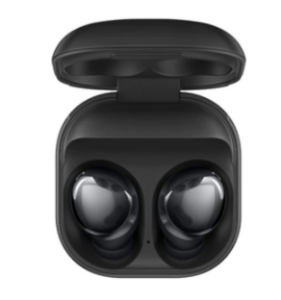
The charging case is one of the two main components of the product. It does what its name entails, charges the device. However, to charge the device, it also houses numerous sub parts or components that work together to ensure the proper function. The first component would be the outer shell, which just houses everything and has a resistant hinge that snaps close to ensure that the device does not open at the wrong time.
Figure Two : Top/Bottom Half of Outer Shell (iFixIT, 2021)
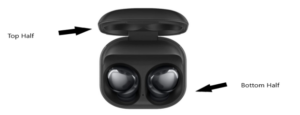
The hinge is made up of a metallic rod within a small hinge bracket that helps it snap close. The top half only has the magnet to help close the case, whereas the bottom half holds everything else. The inner shell holds everything within the bottom half of the case. The inner shell is held into place by its size which provides a snug fit, a few magnets, and a ribbon cable.
Figure Three: Inner shell (iFixIT, 2021)
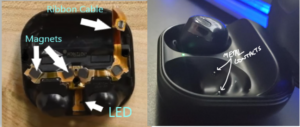
The image above shows there are not any outer screws that holds the inner shell within the bottom half of the outer shell, but there’s a ribbon cable present. The ribbon cable above is used to connect the LED and the metal contact points to the circuit board to receive power. It is located at the bottom of the image between the area where the buds are placed. This LED is used to indicate what power level the Buds are at and whether they need to be charged. The metal contact points located above the LED are used to transfer power from the ribbon cable to the individual buds. Lastly, the magnets assist in holding the inner case within the outer shell.
Figure Four: Inside the Bottom Half of the Case (iFixIT, 2021)
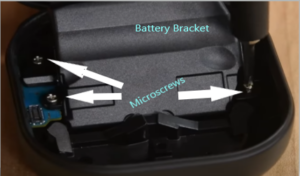
After the inner shell is removed and the ribbon cable is disconnected, the next component located within the bottom shell is the battery bracket . It is held within the case by three Philips screws approximately 0.2 inches in length and its purpose is to house the battery. The battery bracket main purpose is to hold the battery, and it can be opened by a few clips which hold the battery bracket together.
Figure Five: Battery Bracket and the Battery (iFixIT, 2021)
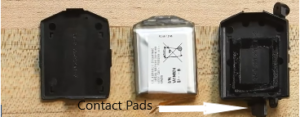
The lithium-ion battery is a 1.81-watt hour cell which holds 13 hours of charge. It is connected to the motherboard via contact pads located on the battery bracket and the motherboard controls the function of the battery.
Figure 5: The Circuit Board/ USB C Port / Charging Coil (iFixIT, 2021)
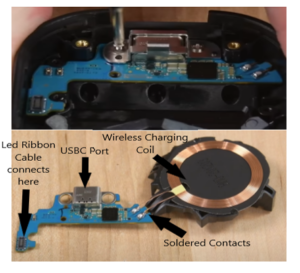
The circuit board is held into the case by three similar Philips screws which are also approximately 0.2’’ in length. It also has the USB C port connected to the front built into the circuit board, and the wireless charging coil soldered on. The circuit board performs all necessary operation for the charging case. If the charge on the battery is low, it sends power and a signal to the LED to indicate its charge. In addition, it directs power through the ribbon cable that connects it to the inner shell to give power to the buds. The circuit board also directs any incoming power from the wireless charging coil or the usb c port towards the battery. Lastly, it directs power to the buds when they are placed inside the case. The wireless charging coil and the USB C both serve a similar function of providing power to the battery.
The Galaxy Buds
Figure 6: Outer Shell/ Housing and the Silicon Tips (Samsung, 2021)
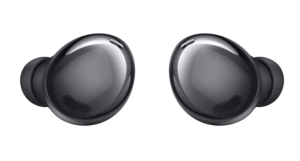
The outer shell or housing has an oval shaped design that comes in various colors such as violet, black, and silver. The oval shape design was implemented to assist with noise cancellation because it can fit the ear snugger than the previous bean shaped device they designed called the Buds live. Samsung also uses silicon tips at the ear end of the buds to ensure that they fit comfortably within the ear for a longer period without discomfort. The housing is made up of two parts, the top and bottom half, and they are held together by an Adhesive. The adhesive is also used throughout the buds to keep some of the micro components in place, but its primary purpose is providing a seal strong enough to keep the product water resistant. The Buds pro has one of the highest water-resistant ratings which allows them to be submerged under one meter of water for a maximum of thirty minutes.
Figure 7 : Wind Chamber / Mesh (Samsung Channel, 2021)
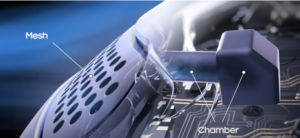
The outer shell of the buds also incorporates both a wind chamber and a mesh system built into it. These two serve one purpose that has been an issue with most headphones throughout history, wind. The mesh is used to block most of the wind that enters within the Buds pro. Any wind that makes it past the mesh gets dispersed within the wind chamber to ensure it doesn’t affect sound or call quality.
Figure 8: Main Subcomponents (Samsung Channel, 2021)
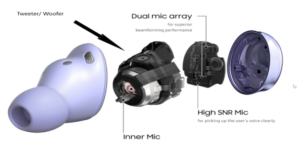
Once the Outer shell is split open there are a few central components, the battery and its connections, the motherboard, and the speakers. Starting from right to left, the motherboard is the next subcomponent.
Figure 9: Motherboard
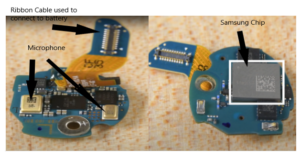
The motherboard acts as the brain of the component, similar to the charging case it performs all the central functions of the item. The motherboard is held into place by a 0.2’’ Philips head screw. It also connects to other components via a ribbon cable which will be discussed later. The most noticeable component on the motherboard is the Samsung chip or the silver square, and the yellow rectangular microphone. The microphone’s purpose is relatively simple, it picks up ambient sounds or audio around the user. There are two microphones located on the motherboard, and there is also another microphone located more closely to the speakers that work with the two outer microphones. It is located at the innermost part of the buds which is the part that goes into the ear. The inner microphone detects in ear audio, and the Samsung chipset generates an anti-noise signal that cancels out 99% of background noise. The Samsung chipset also incorporates different functions with low latency or lag such as ambient sound. Ambient sound allows for the user to listen to other individuals talking without physically interacting with the buds to prevent the user from being unaware of their surroundings. The chipset accomplishes this in relation with a Voice pickup unit located below the Samsung chipset. This is used to detect voices used with ambient sound so that the buds automatically detect another person and allow for easier communication. In addition, it’s used with the two microphones to perform a technique called beamforming, which funnels the user’s voice directly towards the earbuds.
Figure 10: Voice Pickup Unit (Samsung Channel, 2021)
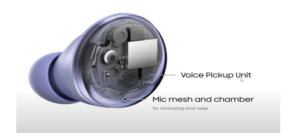
As stated before, the mother connects to the next component via a ribbon cable, that component being the connector board for the battery.
Figure 11: Battery Bracket/ Connector Board / Battery (iFixIT, 2021)
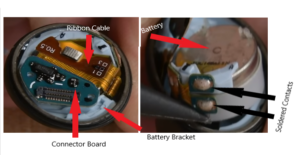
The battery bracket main purpose is to hold the battery in place. Although there is adhesive between the battery bracket and the speaker located under the component, the battery bracket was still soldered to the battery and the connector board for a secure connection. The connector board is used to direct power from the battery towards the speaker and/or the motherboard to power the various components via ribbon cables. The battery itself is a custom-made Samsung battery. It is a 0.22 watt per hour battery that holds approximately 8 hours’ worth of charge.
Figure 12: 2-way Speakers (Samsung Channel, 2021)
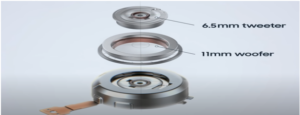
Finally, the speakers. Previous models developed by both Samsung and their competitors failed to create a two-way speaker due to the space constraint within the earphone. However, due to recent innovations, Samsung made compact chipsets that assisted in combining both a woofer and a tweeter. The woofer is used to deliver bass, whereas a tweeter is used to deliver high pitches. Together, when the two are combined into one they provide high sound quality that has not been accomplished before within a tiny space.
Conclusion
Although there are various arguments and claims between the big, branded companies over who has the best product, Samsung with its recent innovation is the furthest ahead. The Galaxy Buds Pro provides all the necessary functions that a truly wireless headphone should produce while adding functions the competitors does not. It provides the user with great quality sound without the need of wires and unnecessary components making it very compact. With the new developments in hardware such as the wind mesh and two-way speaker, and the intelligent active noise control, and functions such as beamforming and ambient sound, they provided an innovation that is both simple and useful to own.
References
iFixIT. (2021, 1 28). Galaxy Buds Pro Teardown. Youtube.com. Retrieved 03 14, 2021, from https://www.youtube.com/watch?v=7QQjHm1l–w
Samsung. (2021, 01 14). Samsung News Room. Samsung Innovation. Retrieved 03 14, 2021, from https://news.samsung.com/us/samsung-galaxy-buds-pro-unpacked-2021-epic-sound-for-every-moment/
Samsung Channel. (2021, 01 14). Galaxy Buds Pro: Untold Stories | Samsung. YouTube. Retrieved 03 15, 2021, from https://www.youtube.com/watch?v=f8m8EyNgoqo

